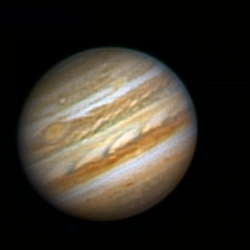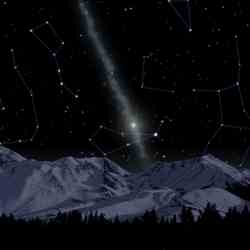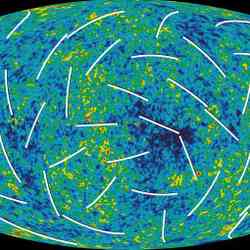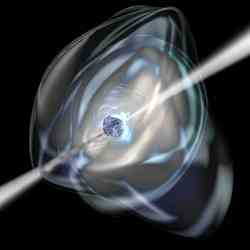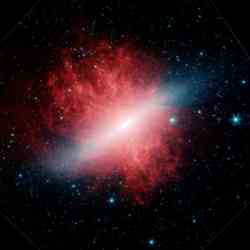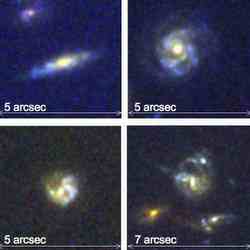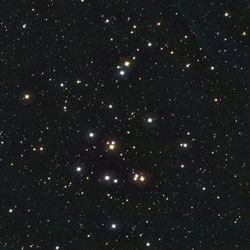
M44: The Beehive. Image credit: NOAO/AURA/NSF. Click to enlarge.
Greetings, fellow SkyWatchers! This week brings darker skies, bright star clusters, meteor showers, unusual nebulae and a chance to participate in G.L.O.B.E. at Night! Whether you use a telescope, binoculars, or just your eyes – you’ll find a wealth of astronomy activities this week. So turn an eye to the sky, because….
Here’s what’s up!
Monday, March 20 – Tonight the obscure constellation of Cancer is now well placed for observation – so why not compare views of the two Messier clusters found there? They’re both binocular and telescope easy!
M44 is one of the most easily recognized studies in the night sky. Like the Pleiades and Hyades in Taurus, Praesepe, “The Manger,” comes to us as a discovery from antiquity. Its myths include one about two neighboring bright stars – Asellus Australis and Asellus Borealis. These two stars are said to be donkeys taking meals from the manger. Known to amateur astronomers as “the Beehive Cluster,” Galileo was the first to discern its stellar nature. Even with his modest scope, he resolved around forty of its brightest members. Modern telescopes have determined that at least 200 of the 350 or more stars visually associated with M44 move together and are a part of the 700 million year old open cluster.
Open cluster M67 is little less than a fist width southeast of M44, or about a finger-width west of visual star – Acubens (Alpha Cancri). Five times further away than M44, and at 3.5 billion years of age, M67 is one of the oldest open clusters in our galaxy. Its brightest stars have already gone “white dwarf” after long ago exhausting their nuclear fuel. You’ll notice it’s quite dense and surprisingly faint for a Messier study. Its discoverer, Johann Gottfried Koehler, was unable to resolve any stars! Today’s telescopes resolve dozens – even hundreds – of cluster members while most binoculars will find it to appear quite “galactic!”
Be on the lookout for Antares as it and the Moon rise together. There will be an occultation tonight, so be sure to check IOTA for times and details in your area.
Tuesday, March 21 – How about one last open cluster before going galaxy hunting? Our study – M48 – is roughly 3 degrees southeast of Zeta Monocerotis. Like M44 in Cancer, M48 lies within the limits of unaided sight. Its brightest member is a spectral type A star, intrinsically some 70 times brighter than our own Sun, but it only appears close to 9th magnitude thanks to 1500 light-years separating us. M48 is quite large, and will show several dozen stars within reach of small scopes and binoculars.
Spring has arrived and with it comes the time of galaxies. To celebrate this new astronomical season, have a look at NGC 2903. Located about a finger-width south-southeast of Lambda Leonis, this 8.9 magnitude tilted spiral looks very much like a slightly fainter version of M81 in Ursa Major. Larger scopes easily catch hints of the galaxy’s spiral extensions and all will show considerable brightening toward the very expansive core region!
Wednesday, March 22 – Born on this day in 1799 was Friedrich Argelander, a compiler of star catalogues. Argelander also studied variable stars and created the first international astronomical organization entitled simply the “Astronomical Society.”
If you’d like to join in an Astronomical Society event, then take the time to visit the Astronomical League webpages and participate in the National Optical Astronomy Observatory (NOAO) call to all observers to participate in G.L.O.B.E. at Night program. No special equipment is needed and your observations “count”!
With a later moonrise tonight, let’s have a look at two meteor showers. We’ll start first with the Camelopardalids. These have no definite peak, and a screaming fall rate of only one per hour. They do have one claim to fame however – these are the slowest meteors known – arriving at a speed of only 7 kilometers per second!
Far more interesting will be to watch for the peak of the March Geminids. These were first discovered and recorded in 1973, then confirmed in 1975. With a much improved fall rate of about 40 per hour, these faster meteors will be fun to follow. When you do see a bright streak, trace it back to its point of origin. Did you see a Camelopardalid? Or a March Geminid?
While out, let’s use the late rise of the Moon to our advantage and head about 2 degrees northeast of star 13 in Monoceros. Our study will be NGC 2261 – more commonly known as “Hubble’s Variable Nebula.” Named for Edwin Hubble, this 10th magnitude object is very blue in appearance through larger apertures, and a true enigma. The fueling star, the variable R Monocerotis, does not display a normal stellar spectrum and may be a proto-planetary system. R is usually lost in the high surface brightness of the “comet-like” structure of the nebula, yet the nebula itself varies with no predictable timetable – perhaps due to dark masses shadowing the star. We do not even know how far away it is, because there is no detectable parallax!
Thursday, March 23 – Today in 1840, the first photograph of the Moon was taken. The daguerreotype plate was exposed by American astronomer and medical doctor, J. W. Draper. Draper’s fascination with chemical responses to light also led him to another first — a photo of the Orion Nebula.
Tonight let’s have a look at a study in light and dark as we view our large binocular and telescope study for this evening. You’ll find it located roughly halfway between Sirius and Alpha Monocerotis – NGC 2359. Known as “Thor’s Helmut,” this bubble-like emission nebula was blown into existence by the superheated blue giant star in its center. NGC 2359 spans about 30 light-years some 15,000 light-years away. The supercharging Wolf-Rayet star produces high speed stellar winds which may have interacted with a nearby molecular cloud giving this strange nebula its curved shape. At magnitude 11, “Thor’s Helmut” is an unusual observation to add to your collection of “head gear.”
Friday, March 24 – Today is the birthday of Walter Baade. Born in 1893, Baade was the first to resolve the Andromeda galaxy’s companions into individual stars and developed the concept of the two types of stellar populations in galaxies. Among his many achievements, Baade is also well known for discovering an area towards our galactic center (M24) which is relatively free of dust, now known as “Baade’s Window.”
Although “Baade’s Window” is a summer sky study, we can take the time this evening to study an area on the opposite side of the sky. Astronomers use a celestial coordinate system based on “hours:minutes:seconds” for east-west location (right ascension – RA) and “degrees” for north-south (declination – DEC) position. It just so happens that should you turn eye, binoculars, or telescope to a RA-DEC location completely complimentary to the center of Baade’s Window (RA=6hrs:16mins, DEC=18.29 degrees) you will find yourself about mid-way between 3.2 magnitude Mu Geminorum and 4.4 magnitude Nu Orionis. And it is precisely there that you will see something that is almost completely the opposite of what can be seen in Baade’s Window – which is to say, “not much.”
Saturday, March 25 – Today in 1655, Titan – Saturn’s largest satellite – was discovered by Christian Huygens. 350 years later, a probe named for Huygens captured the attention of the world as it descended by parachute onto Titan’s surface and sent back information on that distant moon. Huygens also went on to discover Saturn’s ring system in 1655. So while Saturn still rides high in the sky, make your own return visit and tour Saturn’s rings and satellites. The siren song of Titan awaits you!
Also on this date in 1951, 21 cm wavelength radiation from atomic hydrogen in the Milky Way was first detected. 1420 MHz H I, neutral – but non-molecular, hydrogen studies continue to form the basis of large parts of modern radio astronomy. Milky Way H I regions are generally free of stars since they heat the stable hydrogen gases and cause them to emit light. Using 21 cm radio-telescopy, astronomers can map the distribution of non-stellar matter in the interstellar medium – the vast regions of space between the stars. Because radio waves can penetrate dust also found in the interstellar medium, we know much more about the distribution of hydrogen gas in our galaxy than would otherwise be possible.
Although stable hydrogen gas is invisible optically, its presence is especially concentrated along the disk of our galaxy in its vast spiral arms. One such region is associated with the Orion Complex. So take some time to scan the sky due south of 3.4 magnitude Eta Orionis and note how few stars are visible between it and 4.2 magnitude 29 Orionis – some 5 and a half degrees away. Such regions are known to have high concentrations of 21 cm radiation caused by hydrogen gas that has yet to begin coalescing into new Suns such as our own.
Sunday, March 26 – Tonight, let’s have a look at the “Eight-burst Planetary.” But, we have to warn you, it isn’t easy for the northern hemisphere. Start by locating Alpha Hydrae. Now drop more than a hand span due south to Psi in Vela. With Psi centered at low power, you can simply wait a little less than half an hour for NGC 3132 to “drift” into the field, or move due east 7 degrees. Either way should reveal this superb 8th magnitude “Southern Ring Nebula!” Look for a “tilt” in brightness across this 2000 light-year distant ring plus its central star. Use high power – this one is less than half the size of the famed “Northern Ring Nebula” – M57.
May all your journeys be at light speed… ~Tammy Plotner (with Jeff Barbour).

